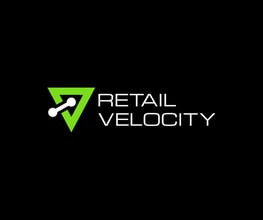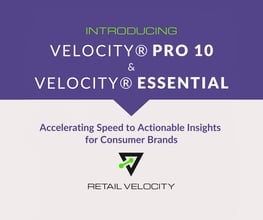
VELOCITY® Technical Overview
Table of Contents
VELOCITY® Overview and Architecture
VELOCITY® is a cloud-based, scalable demand signal repository (DSR) developed for consumer packaged goods companies (CPGs). Launched in 1994, the VELOCITY retail data platform automatically aggregates, cleanses, normalizes, harmonizes, and stores large volumes of diverse demand data such as point-of-sale (POS) data, wholesaler data, electronic data interchange (EDI), inventory movement, promotional data, and customer loyalty data. Our industry-leading platform also enables CPGs to collect and seamlessly integrate syndicated retail data and third-party data, such as demographics, weather, and social media, with demand data.
A major strength of VELOCITY is that it unifies and centralizes data for easy access, sharing, and utilization by various business units and decision support applications. This results in quicker, more precise, and dependable insights for collaborative decision-making, optimizing retail performance, and ensuring sustainable growth.
At the enterprise level, VELOCITY can provide a solid foundation for a comprehensive and effective information architecture strategy, enabling improved reporting, analytics, and advanced AI and Generative AI.
VELOCITY offers an expansive suite of advanced features and functions that have been developed by industry experts over the past 30 years to meet the diverse and ever-changing needs of consumer brands and retailers to satisfy demand. Our solution is based in Microsoft Azure to provide our clients with unsurpassed multilayered cloud security and optimal data availability.
The specific details of how VELOCITY operates are behind the scenes, meaning you don’t have to worry about setting up the technical aspects of the solution. Retail Velocity manages the heavy lifting. VELOCITY can interface data inputs and outputs with commonly used systems such as trade promotion management, demand planning, and ERP.
VELOCITY also offers over 600 available retail data connectors and adaptors that determine the automated retail data retrieval and input method from various retailers and distributors. It also performs special transformations, data cleansing, normalization, and harmonization of different types of vendor and retailer data. Additionally, VELOCITY functionality is also available for custom-built data adaptors, allowing consumption and preparation of any data, even if a CPG has not dealt with it before.
Data Retrieval and Data Inputs
To run your business most efficiently, you need accurate, timely data at the most granular level to track and analyze the velocity of your products and effectively manage your inventory across retailers. Data retrieval and data input methods are ways in which you can ingest and transfer your data to VELOCITY.
With VELOCITY, you can pull POS and inventory data from various sources using different methods like secure FTP, email inboxes, Azure Blob Storage, retailer portals, ODBC, and API endpoints. Retailer portals have their own nuances, from easy “login and click a button to download this week’s report” to more difficult “configure the data you want in the report and queue it for downloading.” 
All the automated data retrieval methods that VELOCITY provides are designed to reduce the effort required by your data, sales, and business analysts to manually pull and manipulate data. Some data extraction methods still require the data to pass through your corporate network, while others completely bypass the “middleman” and allow VELOCITY to access the source directly. Here are a couple of examples of data retrieval methods that allow VELOCITY to access the data source directly:
- ODBC connections (e.g., Dollar General, Family Dollar, and Home Depot)
- API endpoints (e.g., Target, Amazon, and Walmart)
For all data retrieval methods, Retail Velocity always requires accounts to be provisioned through the client to grant us access. This ensures that you retain control over the security of your data.
As part of these data integrations, VELOCITY will automatically update item-level and store-level data daily from all retailers, ensuring you always have the most recent information at your fingertips.
Data Formats
VELOCITY supports various data formats, regardless of the method used for data retrieval or input. Some common formats are plain text formatting like comma-separated and tab-separated values and structured formats like Microsoft Excel (XLSX) and EDI.
VELOCITY can consume numerous data points:
- POS (ongoing and historical, store, online/e-commerce, and chain)
- Inventory (store, warehouse, online, and chain)
- Forecasts
- Shipments
- Customer Item and Store Lists, Hierarchies
- Master Items and Hierarchies
- And much more
Data Translations and Cleansing
When data is imported into VELOCITY, it undergoes data cleansing. The source fields are then translated to VELOCITY using available references such as dates, fiscal periods, master items, stores, and retailer codes. You can translate dates from any source format, adjust them to a week’s end date when working with weeks, and use various fiscal year and period identifiers to identify a day or week based on your corporate or the retailer’s fiscal calendar.
VELOCITY has numerous standard functions to cleanse inbound data, such as translating incorrectly formatted UPCs, discarding references to non-vendor items, resolving check digits, and differentiating the retailer codes based on dates used.
Data Normalization and Harmonization
VELOCITY automates the ingestion of all retail data and organizes and stores it in a standardized, normalized snowflake schema to ensure data consistency across different retailers. The snowflake schema organizes the data across four dimensions, allowing users to create multiple product and store attributes and hierarchies as needed.
VELOCITY regularly harmonizes multiple sources of information per retailer to build an entire picture of the puzzle. Each retailer product code is harmonized with your master item codes. While each retailer has its own fiscal calendar for reporting data, all retailers’ fiscal calendars are harmonized with your corporate fiscal calendar so that all retailer data can be reported, and you can have unified reporting across your organization.
Data Enrichment Processes
One of the most common data enrichment processes that benefit CPG companies is rolling up daily sales (and other data) to weekly sales, which allows you to view data at the most granular level (days) or at the most common level (weeks) for comparison across retailers. VELOCITY includes additional data enrichment functionality for calculating or identifying perpetual inventory, comparable stores, shrink, and out-of-stocks.
During the data enrichment processes, the dimensions are simplified into a star schema, and the data is aggregated to enhance performance.
Pre-built interactve Dashboards and Reports
VELOCITY offers a range of pre-built interactive dashboards and reports available with B2B authentication. These capabilities enable the display of daily and weekly totals across multiple retailers or for a single retailer. Users can drill down to the item and/or store level, among other functionalities. Dashboards also exist for IT personnel to monitor the status of data and check for problems or errors. The built-in user-based access and security ensures users only see data for the retailers over which they have governance.
Data Models for Third-party Reporting
All data in the dashboards and reports are also available for consumption by, or integration with, third-party reporting tools. Standard data models exist as Microsoft Analysis Services cubes for powerful and fast querying by OLAP-ready tools, such as Microsoft Power BI and Microsoft Excel. Data models are also available through SQL as a tabular source.
When using VELOCITY, pre-defined calculations are at your fingertips daily. These calculations include but are not limited to:
Incremental Output Tables
VELOCITY keeps track of all changes to activity data. This allows you to pull only the data that has changed. This is important especially if you would rather integrate the cleaned and harmonized data from VELOCITY into your current ERP system or other applications to generate reports from there. You can schedule processes to pull data at intervals of 15 minutes, every hour, or any frequency you prefer, ensuring that you stay as up to date as possible without needing to manage extensive re-restatements of unchanged data.
no need to REINVENT THE WHEEL
30 years ago, VELOCITY set the standard for Demand Signal Repositories. Our dedicated and highly experienced team handles the complexities of retail data collection, integration, and harmonization for you, so you don’t need to learn all the details and reinvent the wheel for the data management processes mentioned above. Implementing a modern data platform like VELOCITY enables CPGs to spend less time and money wrangling and wrestling data and more time analyzing accurate, near real-time data to develop actionable insights that drive confident business decisions and profitable growth.
No one knows your business better than you, and no one knows retail data collection, cleansing, and harmonization better than Retail Velocity. Let's talk and see how we can help you grow your business.

